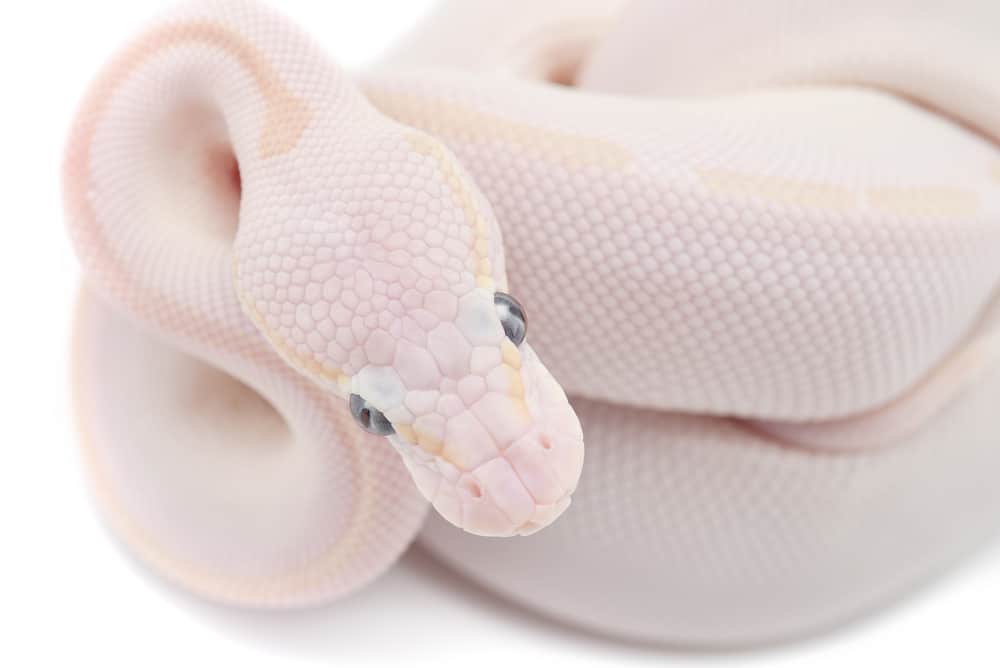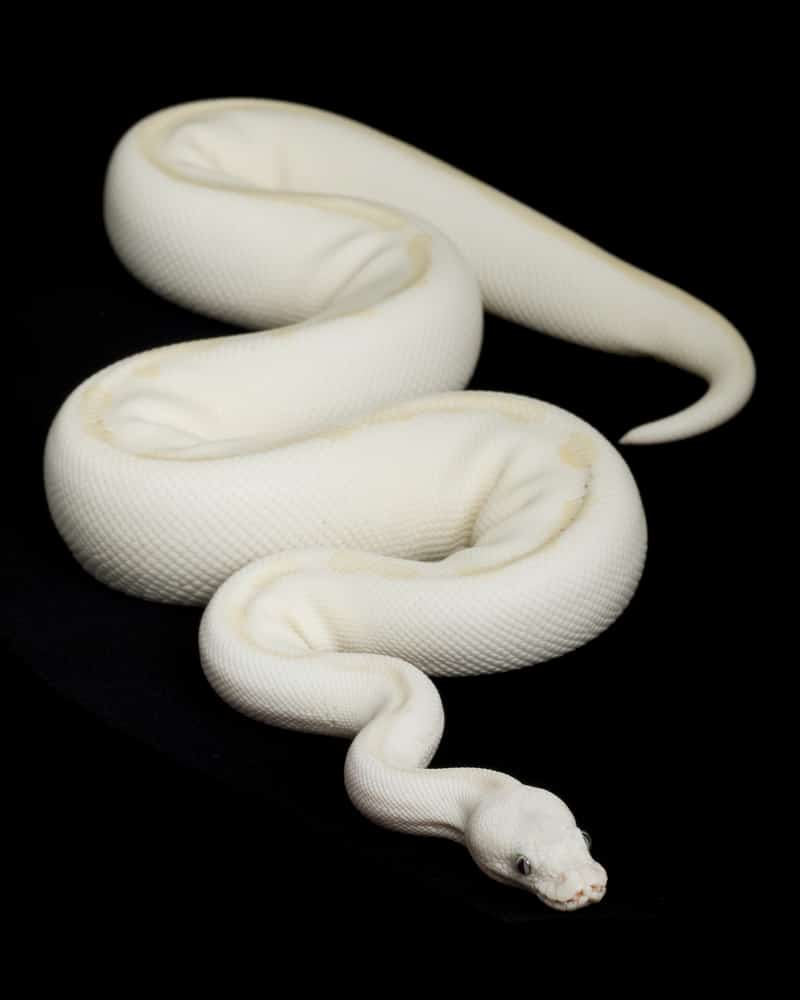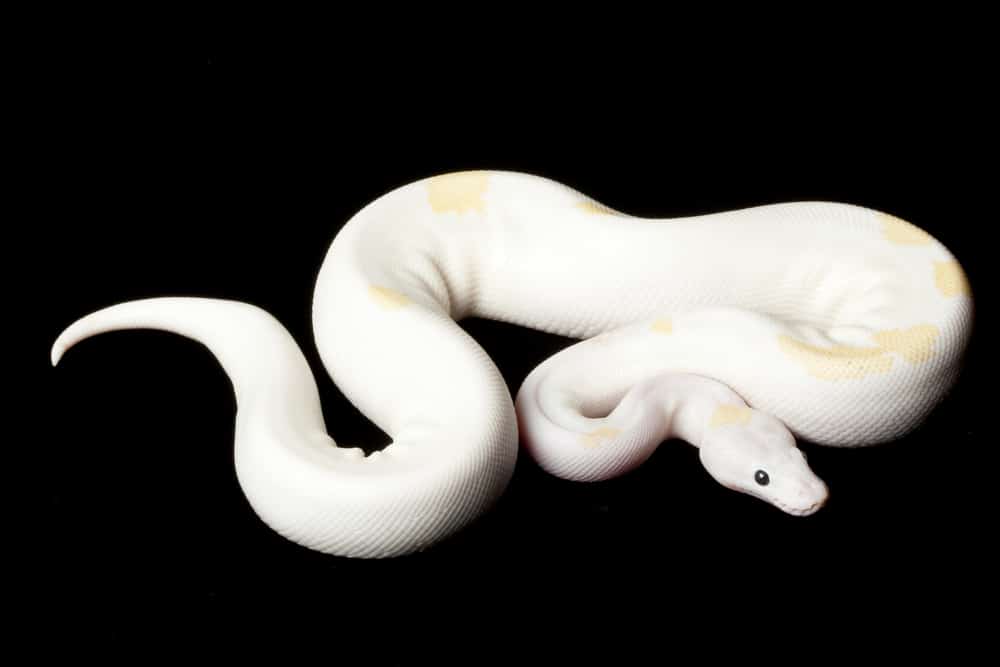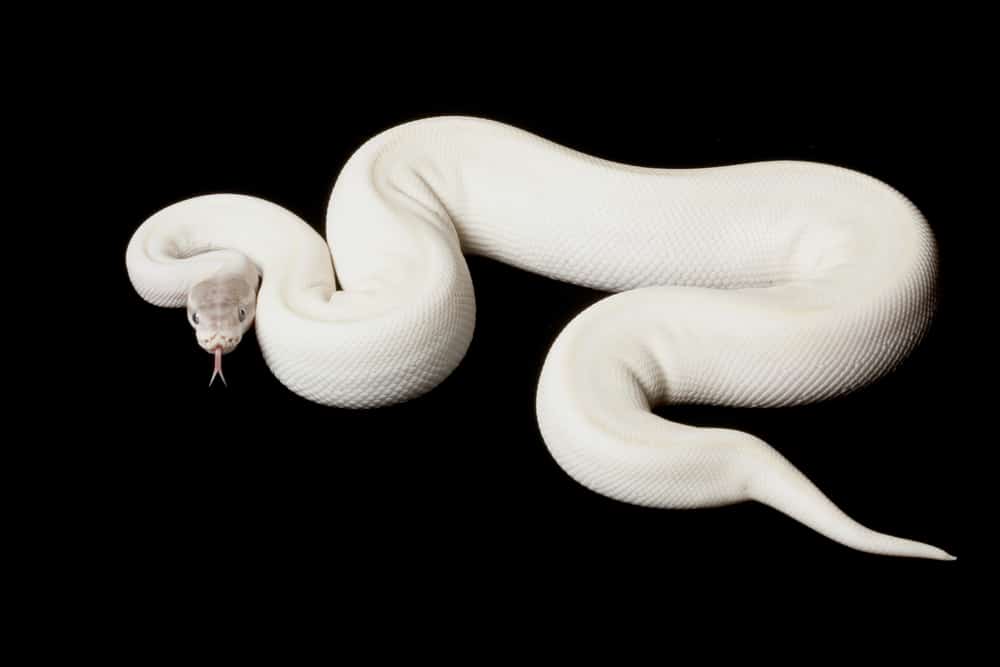Ball pythons are currently available in a kaleidoscope of color and pattern mutations. Some of these mutations are relatively subtle, and only involve small alterations in the natural color and pattern of the species, but others cause ball pythons to display mind-blowing colors and patterns.
And while there are a few different mutations in the latter category, leucistic ball pythons may be the best example. Essentially all white animals with dark rather than red eyes, leucistic ball pythons are some of the most jaw-dropping snakes available to snake keepers.

We’ll dive into the leucistic ball python mutation below and explain everything you need to know about it, in case you’re thinking about adding an all-white ball python to your collection.
Quick Navigation
What Does “Leucistic” Mean?
The term “leucistic” refers to animals that do not produce melanin as well as they normally should. They’re usually described as exhibiting a partial loss of pigment.
In some cases, this causes animals to appear all white or nearly so. However, unlike amelanistic (albino) animals, leucistic animals usually have dark-colored eyes. Additionally, some leucistic animals display muted colors or pattern elements instead of being completely white. In some cases, areas of black pigmentation still occur.
Leucism occurs in several different branches of the tree of life. Scientists have documented leucism in several deer species, killer whales, bears, giraffes and buffalo, as well as, obviously, snakes. Leucistic Texas rat snakes, for example, have been kept by snake enthusiasts for decades. For that matter, the piebald mutation is generally considered a type of leucism.
Leucistic Ball Python Appearance
Before going further, it is important to note that there are two different types of leucistic ball python, as well as the ivory ball python, which is somewhat similar and often included in these discussions.

- Blue-Eyed Leucistic – Blue-eyed leucistic ball pythons are typically off-white to pure white animals with blue-colored eyes. Some are slightly pinkish, rather than pure white, and a small number display normal (dark) patches of pigment.
- Black-Eyed Leucistic – Black-eyed leucistic ball pythons are essentially identical to blue-eyed leucistics, except that their eyes are black, rather than blue. They are usually off-white to pure white in color, too occasionally exhibit areas with normal pigmentation.
- Ivory – Ivory ball pythons look broadly similar to leucistic ball pythons, but they generally have a pinker appearance, and their patterns (particularly on the head) are more visible than they are in leucistic animals. They typically have a light-colored dorsal stripe and dark eyes.
We’re not going to discuss ivory ball pythons further, but we wanted to provide a description for those who weren’t familiar with the way they differ from blue- and black-eyed leucistics.
It is important to understand that snakes displaying these mutations all vary to different degrees, so one blue-eyed leucistic may look brighter white than another, or one black-eyed leucistic may display more areas of normal pattern elements than another.
Genetics and Patterns of Inheritance
Both types of leucistic ball pythons exhibit a co-dominant/incomplete dominant pattern of inheritance. This means that:
- Animals with no copies of the mutated gene appear normal
- Animals with one copy of the mutated gene exhibit a relatively minor degree of pattern or color mutation
- Animals with two copies of the gene have a drastically altered appearance (in this case, they are leucistic)
As an example, consider the pastel mutation.
Animals without a copy of the gene appear normal, while those who have one copy of the gene (known as heterozygous) are slightly brighter with slightly altered patterns. Animals with two copies of the mutated gene – super pastels – have more drastic changes in color and pattern. Those with two copies of the gene are referred to as homozygous.
You can contrast this with simple recessive traits, such as albino ball pythons. This mutation doesn’t cause any visual indicators that an animal has one copy of the gene – they only look different (the trait is only expressed) when two copies are present.
It is also distinct from dominant mutations, in which there is no difference in appearance between animals that have one copy of the gene and those with two. The spider mutation may be an example of a dominant mutation (we don’t yet know for sure).
The black-eyed leucistic is pretty straightforward: It is the homozygous or “super” form of the yellow-bellied ball python mutation. Breed two yellow-bellied ball pythons together and (statistically speaking), 25% of the clutch should be black-eyed leucistics. Meanwhile, 50% of the clutch will be yellow-bellied snakes, and 25% of the animals will be completely normal.

The heterozygous form of the black-eyed leucistic is the fire ball python. However, there are several different lines of the fire trait, and they’re all thought to be compatible with each other.
However, the blue-eyed leucistic is a bit different, so we’ll discuss it further in the following section.
The Blue-Eyed Leucistic Complex
Interestingly, and unlike most other mutations, the blue-eyed leucistic morph is associated with several different genes. These different genes can all be combined to produce a blue-eyed leucistic.
Ball python breeders and keepers typically refer to these mutations as being part of the “blue-eyed leucistic complex.” Breeders are discovering that more and more genes are part of this complex, but, as is currently understood, the following mutations belong to the group:
- Mojave
- Butter
- Lesser Platinum
- Bamboo
- Phantom
- Mystic
- Mocha
- Special
- Daddy
The degree to which the homozygous forms of these animals appear leucistic varies both among individuals and with the traits used to produce them.
Potential Problems Associated with the Trait
Unfortunately, some color and pattern mutations are associated (or appear to be associated) with health problems. The spider ball python mutation, for example, is associated with neurological problems – called the “spider wobble.” Similarly, many albino animals of all types have particularly sensitive eyes.
Most leucistic ball pythons appear relatively healthy. They don’t typically present neurological problems like spider ball pythons (and some other mutations). Additionally, although it should be obvious, the white color associated with the homozygous form of the mutation is not lethal. This is noteworthy, as all-white mutations are lethal in some other species.
Nevertheless, some blue-eyed leucistic animals exhibit protruding eyes (typically called “bug eyes”). These seem to be most common with leucistics produced by animals with the butter or lesser platinum gene. It isn’t entirely clear yet, but it doesn’t appear that these enlarged eyes cause tangible problems for the snakes.
Can You Combine the Leucistic Mutation with Others?
At the time this article was written, it doesn’t appear that anyone has successfully created a snake that displays leucism and another color or pattern mutation. It’s not clear whether or not this is possible, nor is it clear what the resulting offspring would look like.
Strange things can happen when different color and pattern mutations are combined, so it will be interesting to see the outcome of these types of projects. It is possible that we’ll find that the results of crossing leucistic ball pythons with other morphs creates nothing special, or that it even causes harmful side-effects. We just won’t know until breeders try.

Caring for a Leucistic Ball Python
Fortunately, leucistic ball pythons (both types) appear to thrive with the same basic care that normal ball pythons do. They require the same amount of space, level of humidity and temperatures that normal ball pythons do, and they should be fed similar diets.
Further, they do not appear to have a particular sensitivity to light. However, like all ball pythons, they are nocturnal animals, who will typically retreat from bright lighting if given the chance to do so.
Blue-eyed leucistics that have enlarged eyes don’t appear to have any unique care requirements, although it is likely wise to be more protective than you’d usually be of the snake’s eyes. For example, you’ll want to pay a little more attention to your snake’s eyes following shed cycles to ensure the spectacle has been shed completely.
Additionally, though it is wise to do so with all snakes, it is probably a good idea to feed only pre-killed or frozen-thawed rodents to these snakes, as their eyes are more vulnerable than those of other snakes, given their large size.
Conclusion
There was a time when the notion of an all-white ball python would have been considered a fantasy. But fortunately, thanks to the work of breeders, all-white ball pythons are not only available, but increasingly common and affordable in the marketplace. And because leucistic ball pythons can be produced by a variety of different color and pattern mutations, the number available will only continue to grow with the coming years.
Additionally, we may begin to see other color and pattern mutations combined with leucistic ball pythons. If this turns out to be possible, then who knows what the future holds? Will we see white animals with bold stripes or complex patterns? Will we find that they produce completely unforeseen snakes with completely different color patterns?
Only time will tell.